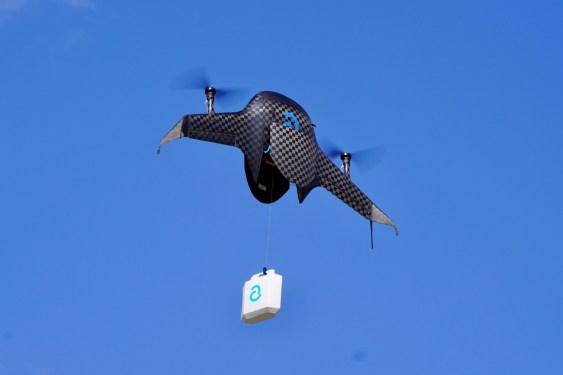Airbound, an Indian drone startup, has raised eight point six five million dollars in seed funding. The round was led by Lachy Groom, a co-founder of Physical Intelligence. This funding comes as the company begins a drone delivery pilot with a private hospital and works toward its goal of one-cent delivery using its ultra-light, blended-wing-body aircraft.
Other participants in the seed round include Humba Ventures and Airbound’s existing investor Lightspeed Venture Partners. Senior leaders from companies like Tesla, SpaceX, and Anduril also joined the funding.
The company was founded in 2020 by Naman Pushp. He was fifteen years old at the time and is now twenty. Airbound has developed an aircraft that uses a tail-sitter design, where the drone sits vertically and launches upright like a rocket. It also features a carbon fiber frame. The aim is to deliver parcels at up to twenty times lower cost than conventional methods and significantly cheaper than existing drone delivery systems.
The aircraft uses a blended-wing-body shape with two propellers, rather than the more common quadcopter configuration. This design allows the aircraft to take off like a rocket and then fly like a plane.
Founder and CEO Pushp stated that Airbound is targeting one-cent deliveries by fundamentally rethinking how energy is used to move goods. He explained that in India, electric two-wheelers are typically used for deliveries of payloads under three kilograms. However, these vehicles weigh around one hundred and fifty kilograms and cost about two rupees per kilometer in energy. Airbound aims to cut that cost down to as low as ten paise by using its drone, called the TRT. This drone is built for small payloads and removes the need for a human driver, reducing total transport weight by roughly thirty times. Pushp said this translates into a twenty-fold drop in energy cost per kilometer, making one-cent drone delivery a feasible goal.
The founder believes there are significant gaps in current drone technology. He noted that today’s drones often require four kilograms of drone to lift one kilogram of payload, which he finds inefficient. He also stated that range is a broken metric and that there is no current concept of aerodynamic efficiency with drones.
Airbound’s rocket-like, blended-wing design eliminates the need for additional propellers and heavy moving parts. This improves aerodynamic efficiency over conventional quadcopters. By avoiding propellers that disrupt airflow over the wing, the drone maintains a higher lift-to-drag ratio. This reduces the amount of thrust needed to stay aloft and makes forward flight significantly more energy-efficient.
The first version of Airbound’s drone weighs three point three pounds and can carry a payload of up to two point two pounds. The startup aims for its second version to support a six point six pound payload while weighing just two point six pounds itself. A prototype of this second version is expected to be ready and flying by the middle of next year, with production targeted for the first quarter of 2027.
Pushp views logistics in the world of autonomy as a physics problem. He says it is a game of efficiency and weight, and that having a lower weight and higher efficiency than anyone else is the key to winning.
He began working on Airbound during the COVID-19 lockdown in 2020, inspired by a video of the drone delivery company Zipline. He submitted an early prototype to a hackathon. This prototype was made from two-dimensional slices held together with toothpicks and tape, then sanded to resemble a fiberglass body. It earned a five hundred dollar grant. This experience prompted him to apply to Y Combinator, though he was not accepted. Instead, he received a one thousand dollar grant from the 1517 Fund in 2021, followed by a twenty-five thousand dollar check from Brand Capital and a twelve thousand dollar grant from Emergent Ventures.
At seventeen, Pushp received a term sheet from Lightspeed but waited until after his eighteenth birthday to sign it. He recalled that it was the first legally binding document he ever signed.
The aircraft uses lithium-ion batteries instead of the more commonly used lithium-polymer battery packs. Lithium-ion batteries typically have a cycle life of five hundred to eight hundred cycles, whereas lithium polymer lasts for around one to two hundred cycles. Pushp stated that the biggest cost of operating these drones ends up being their battery replacement costs.
Currently, it costs Airbound two thousand dollars to make each drone, and each delivery costs about twenty-four rupees. The startup aims to cut the delivery cost to below five rupees by the end of 2026. It also projects reaching a million deliveries per day by the middle of 2027. To achieve that, it plans to increase its manufacturing capacity to over one hundred drones per day. This is a significant increase from the startup’s current production rate of one drone per day at its facility in Bengaluru.
Airbound has started its first pilot program with Narayana Health in Bengaluru. Over three months, it will deliver medical logistics, aiming to complete ten deliveries per day of medical tests, blood samples, and other critical supplies.
Beyond medical supplies, Airbound also targets other sectors including quick commerce, food deliveries, and several other smaller areas of last-mile delivery.
The company plans to expand beyond India after scaling to one million deliveries per day and aims to enter the U.S. market in three years. The startup is also in talks with regulators, including India’s Directorate General of Civil Aviation, to begin its flights soon.
To date, Airbound has raised over ten million dollars in total funding and has a team of fifty people. The latest funding round will help scale its manufacturing capabilities and expand operations. The pilot program will also help improve its service and reduce costs to better prepare for broader market adoption in 2026.

